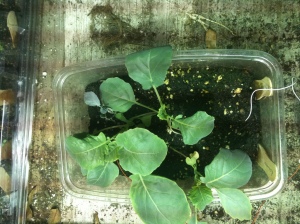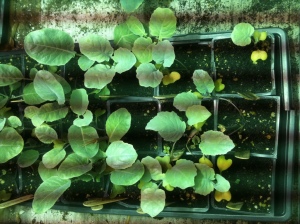Ever since I was an adolescent, I loved finding catalogs and books covering esoteric subjects and arcane scientific knowledge. One thing I came upon was a set of papers archived by Rex Research that covered an amazing array of electrostatic-based inventions and discoveries.
After revisiting the idea once in a while over the years, I recently came across a much greater selection of web-material for the related topic of electro-culture… the concept of growing plants with electricity.
It turns out that the research is published in some books and articles dating from the late 1800s and occasionally up till the 1940s. After figuring out the right keywords, I found some additional studies including one recent article that I have yet to review that discussed the effects of applying electroculture to a commercial hydroponic greenhouse.
My current drive to electroculture came from a deep-desire or perhaps a knowing that the speed by which plants grow can be increased. I was also inspired to experiment more after hearing an interview (on The Cosmic Influence) from John Burke (and Kaj Halberg) speaking about their book Seed of Knowledge, Stone of Plenty: Understanding the Lost Technology of the Ancient Megalith Builders where he talked about research involving a number of sacred sites including Stonehenge, and the various ‘mound’ sites, i.e. Cahokia’s Monk’s mound. His research revealed that at daybreak, and I think especially at the solstices, that these sites were used for fertility rituals by the agrarian societies of their heyday. In his studies, he found that at these times these sites had a significant increase in the electric field strength, and discovered that when seeds were placed in these locations or were exposed to artificially-produced electric fields, that crop yields increased significantly and the plants were hardened against disease. Additionally, there is other research by a number of people and institutions who demonstrate that all sorts of crops can be increased in speed of growth, amount of fruit or harvest, etc. when exposed to a variety of conditions including:
- Static electric fields
- Magnetic fields
- DC
- Negative ions
- AC waveforms over a limited range of frequencies
These topics are very exciting to me! Next, I’ll introduce you to an experiment I started. One of the techniques of electroculture was the creation of an “Earth battery” which consisted of a copper plate at one end of a row and a zinc plate at the other end. Attached to both plates was a piece of rebar connected to each plate by a wire. Then, both plates were connected by a copper wire strung above-ground. When the soil was sufficiently damp, a minute electric current could be measured by means of a galvanometer. In these experiments, a number of benefits came to pass including an increase in crop yields of 20% – 40%, decreased time to fruit, and increased resistance to disease. Similar results came from applying DC between the base and the top of fruit-bearing trees.
To get started, I made an adaptation and figured that i could get a similar effect by using a common DC power supply from an old cell-phone charger. After removing the charging connector and stripping the wires down so I could attach a nail to each terminal, I placed each nail on opposite sides of the growing container and filled over them with soil. I then proceeded to plant some Romanesco broccoli seeds. For the first week I kept the power on for 12-hours per day. Then I figured that it would be better to go all-out and keep power applied 24/7.
After about 1 week, the experimental group (there was a control group also – non-electrified) had stalks about 2x as long as the control group.
After the 2nd week, the leaves on the experimental group were looking a little strange to me… there was a light-green band along the perimeter of the larger leaves. I didn’t know what it meant, and assumed the experiment wasn’t working in a positive manner.
After the 1st month, the difference between both groups was astonishing! While they both were exposed to identical conditions, except for the electricity flowing through the root-structure, the experimental group had leaves that were almost twice as wide as the control, and furthermore, the entire plant had a lush deep-green color to it while the control was more of a pale-ish green. Check out the pictures below:
As you can see from the pictures, the differences between them after 1 month are quite large. I am happy to report that this experiment is starting off as quite a success and will continue to publish updates in the near future.





Hey! great research you’re doing! I started to search about this matter and found your blog. Im planning to make some test in my plants too 🙂 and i want to keep in touch, I already signed your RSS feed. Thanks in advance sharing your research.
http://www.electrocultureandmagnetoculture.com I found this 🙂
Hey! Thanks for your comments! I would like to stay in touch also, for I would like to find/build a community of active experimenters.
I’m working on other experiments but have yet to make another post about it.
Sure! Lets share some experiments and see the results. Im glad to collaborate in this interesting subject 🙂
we are planning to do a study related to this…this would be a great help 🙂
Hey Shirlene,
Thanks for commenting… I just created a site dedicated to my experimental journey on this topic and I would love to hear more about your research. Come to http://ElectricFertilizer.com and leave me a note.
Best of luck in your endeavors!
Hi, I’m a student from Barcelona! I’m really interested in electroculture and I’m doing a research about it. Can you help me in some aspects please? Which are the most suitable seeds should I plant? Which electrical power should I use ? To sum up, it will be awesome if you could help me with the protocol for electroculture.
Thanks for helping! 🙂
Hey Albert,
Thanks for leaving a comment! I’m glad to hear about your interest in electroculture and I would be happy to help you out. Regarding seed selection, historically a number of different plants have been successfully grown including wheat, potatoes, tomatoes, broccoli, carrots, radishes, and bean sprouts. For electrical power, very low voltages work – approximately 1.1V up to 40V and beyond into the 10’s of thousands of volts if you want to use high voltage systems. With DC electroculture, 3-5V works well. The only other thing I would consider is your choice of electrodes… They will be consumed in the electroculture process, so choose something that you don’t mind getting into the soil, e.g. iron via steel or possibly stainless steel.
Please stay in touch, let me know what you decided to try out, and in the meantime check out my other site dedicated to the topic, http://ElectricFertilizer.com
You have helped me a lot by replying my comment. Thank you very much. I’m going to use radish seeds and a 9V generator. I pleased with your suggestions and I’ll tell you how my project is going. How much time should be the generator on ? 1 hour? All day ? Could you tell me please?
We are the students from the University of Cebu in Philippines. We are inspired by your experimentation with Electro-Culture. So we followed your idea for our Investigatory Project. We would ask a little help if using rusty rebar can be a good conductor of this electricty for this set up. And we would also like you to add some comment to our set-up.
Thank you 🙂
We are the students from the University of Cebu in Philippines. We are inspired by your experimentation with Electro-Culture. So we followed your idea for our Investigatory Project. We would ask a little help if using rusty rebar can be a good conductor of electricity for this set up. And we would also like you to add some comment to our set-up. We posted a picture of our set-up in twitter account.
Thank you
I think the admin of this website is actually working hard in favor of his site, since here every information is quality based stuff.
GOOD DAY, I AM giancarlo QUADRI from MONZA-ITALY. I AM GLAD for your magnific and magic work and JOB. at next COMUNICATION, HAVE A SHINE FUTURE gian
Thanks, Giancarlo!
i permited:
you know GEORGES LAKHOVSKY ( 1870-1942)
AND THE book : THE SECRET LIFE of PLANT, WRITE BY PETER TOMPKINS AND Christofer BIRD?
BEST wins for the future
GIAN
Yes… Great books! I’m about to read Electricity in Agriculture and Horticulture by Lemstrom. It looks like it’s filled with good info!